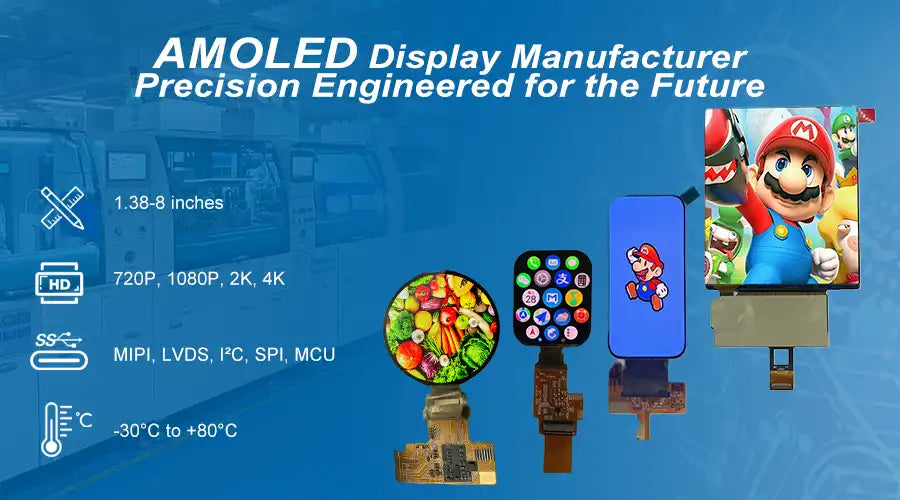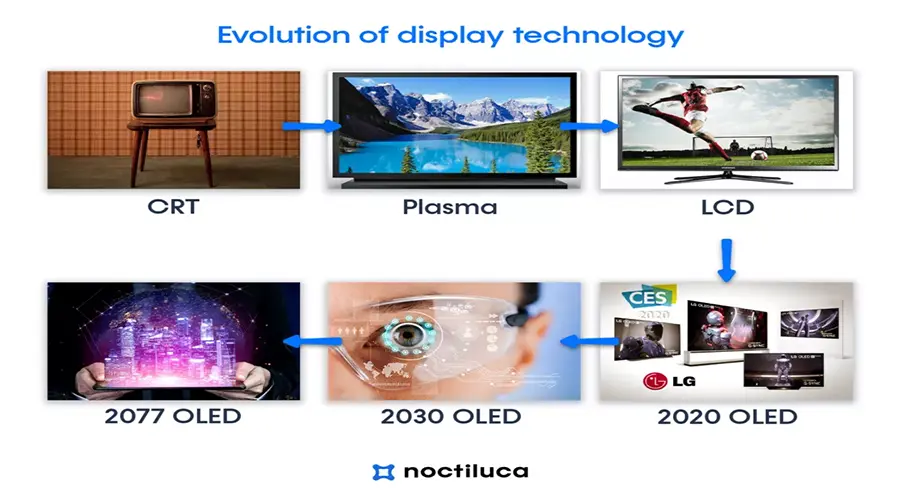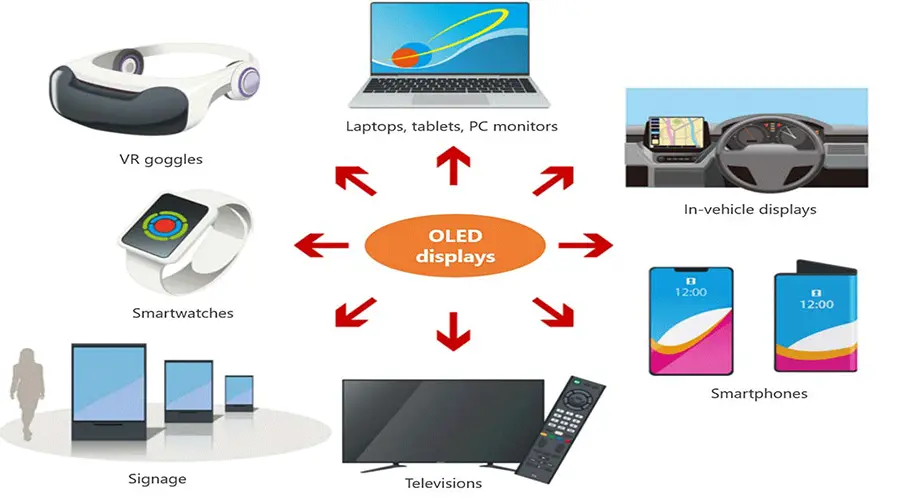Table of Contents
Introduction AMOLED Basics How AMOLED Works TFT Backplane Pixel Circuits & Compensation Emission Stack Sub‑pixel Matrix Optics & Light Pros & Cons Brightness & PWM Eye Comfort Burn‑in & Lifespan AMOLED vs LCD/OLED LTPO & VRR Key Metrics Testing Methods Buying Guide Calibration Care & Practices Use Cases Creator & Gaming 2025+ Trends FAQ ReferencesIntroduction
AMOLED—Active-Matrix Organic Light-Emitting Diode—is a self-emissive display technology where each pixel emits light and can switch completely off for true black. That intrinsic capability grants AMOLED effectively infinite native contrast, superb HDR highlights, and excellent motion clarity. In this guide we translate AMOLED engineering—backplanes, pixel circuits, PWM dimming, compensation, and optical stacks—into practical decisions for teams building products, choosing panels, calibrating color, and optimizing content. BROWNOPTO partners with device makers and content owners to design AMOLED-friendly interfaces and deployment strategies that extend lifespan, sustain brightness, and preserve visual fidelity.
AMOLED differs from older emissive approaches by leveraging a thin-film-transistor (TFT) active matrix beneath each sub‑pixel. The AMOLED active matrix stores and maintains drive levels across the frame interval, enabling precise gray levels at high pixel densities. Because AMOLED power depends on content luminance and chromaticity instead of a global backlight, dark UIs and always‑on display (AOD) can be highly efficient when properly designed. As you evaluate AMOLED vs alternatives—LCD, WRGB OLED TVs, or Mini‑LED backlights—the core decision hinges on room brightness, content APL (average picture level), static UI exposure, and desired form factor.
AMOLED Basics
An AMOLED module integrates a TFT backplane, an OLED emission stack, optical layers, encapsulation, and a driver/timing controller. The backplane addresses AMOLED sub‑pixels row by row, sampling analog data into a storage capacitor that biases the drive transistor. The OLED emission stack converts AMOLED pixel current into photons with spectral characteristics tuned for target gamuts like DCI‑P3. Optical layers and polarizers improve outdoor readability, while encapsulation protects sensitive AMOLED organics from oxygen and moisture. BROWNOPTO focuses on harmonizing AMOLED electronics, optics, and UI design so systems meet both visual and lifetime goals.
- Active-matrix addressing allows AMOLED pixels to hold drive levels between scans, delivering stable luminance.
- Self-emissive AMOLED pixels enable per‑pixel dimming, perfect blacks, and thin modules ideal for foldables.
- AMOLED power is content‑dependent; dark themes and low-APL layouts reduce drain significantly.
On smartphones, AMOLED typically uses high‑mobility LTPS or hybrid LTPO backplanes to hit extreme PPIs, support variable refresh, and maintain low leakage. On laptops and monitors, AMOLED modules increasingly target RGB‑stripe sub‑pixels for crisp typography at desktop viewing distances. Wearables lean on AMOLED’s efficiency for AOD watch faces and sunlight readability with aggressive anti‑reflective stacks.
How AMOLED Works
During each refresh, an AMOLED row is selected by asserting its gate line. The switching transistor samples the data voltage into the AMOLED pixel’s storage capacitor. That stored voltage biases the drive transistor, which regulates AMOLED current through the organic emitter, producing luminance proportional to current density and device efficiency. Compensation corrects TFT threshold drift and aging to keep the AMOLED grayscale linear and the white point stable. The result is predictable brightness even as AMOLED materials age, especially when combined with per‑region compensation for UI elements such as status bars and logos.
TFT Backplane
AMOLED backplanes rely on LTPS for high mobility and compact transistor geometry, IGZO for low leakage and uniformity, or LTPO to fuse both advantages. LTPS excels at high current drive for bright AMOLED emission and high pixel density. Oxide devices exhibit lower leakage, enabling very low refresh rates during static scenes and reducing AMOLED static power. LTPO orchestrates where LTPS and oxide sit in the stack so AMOLED panels can swing between 1–120/144 Hz without visible artifacts. Thermal behavior matters: as AMOLED warms, mobility and Vth shift; controllers adapt to keep the luminance target.
Pixel Circuits & Compensation
AMOLED pixel circuits range from simple 2T1C to multi‑transistor sensing designs. More complex AMOLED circuits measure drive transistor Vth and sometimes estimate OLED aging. The controller builds correction tables and injects offsets so AMOLED pixels still meet the requested luminance. For content with static elements, AMOLED per‑region compensation and pixel shift limit differential wear. BROWNOPTO recommends enabling all vendor AMOLED protections by default for signage, dashboards, and kiosks.
Emission Stack
The AMOLED emission stack sandwiches injection and transport layers around emissive materials tuned for red, green, and blue. Many phone‑class AMOLED displays use phosphorescent red/green and fluorescent blue; WRGB TV OLEDs employ a white AMOLED emitter behind color filters plus an unfiltered white sub‑pixel for brightness. In 2025, tandem AMOLED stacks and micro‑lens arrays improve external quantum efficiency and raise peak luminance without proportionally increasing heat. These advances allow AMOLED devices to hit higher HDR highlights while maintaining lifespan.
Sub‑pixel Matrix
AMOLED smartphones often adopt PenTile (RG‑BG) to balance blue aging and power. Monitors and laptops may prefer RGB stripe for text sharpness. While OS sub‑pixel rendering can mask differences, ultra‑fine UI edges reveal matrix geometry at lower PPIs. BROWNOPTO’s UI kits minimize single‑pixel lines and use anti‑aliasing that respects AMOLED sub‑pixel order to maintain perceived clarity.
Optics & Light
Optical management layers—polarizers, circular polarizers, low‑index films, and AR coatings—reduce reflections and maintain contrast under ambient light. Better outcoupling structures increase AMOLED external efficiency by liberating trapped modes. Outdoor readability depends not just on AMOLED peak luminance but also on ambient contrast ratio (ACR); lowering reflectance is as impactful as raising AMOLED nits.
Pros & Cons
Advantages
- AMOLED achieves perfect black and high ANSI contrast with no blooming.
- AMOLED response is near‑instant, reducing motion blur without heavy overdrive.
- AMOLED modules are thin and flexible, enabling curved and foldable designs.
- AMOLED per‑pixel dimming allows efficient AOD and dark‑UI power savings.
Trade‑offs
- AMOLED burn‑in risk under prolonged bright, static, high‑contrast elements.
- AMOLED full‑field sustained brightness can trail high‑zone Mini‑LED LCDs.
- AMOLED PWM at low nits can bother flicker‑sensitive users without high‑frequency modes.
For most mixed use, AMOLED benefits outweigh trade‑offs. BROWNOPTO typically recommends AMOLED for cinematic rooms and creative review, and Mini‑LED LCD for bright offices with static dashboards.
Brightness & PWM
AMOLED brightness control often combines PWM at low levels (to preserve chroma) with analog (DC) dimming at higher nits. Some panels run high‑frequency PWM ≥960 Hz, making modulation less perceptible. Transition policies, duty shaping, and harmonics determine how comfortable an AMOLED display feels over long workdays. For enterprises, BROWNOPTO’s shortlists favor AMOLED panels with documented high‑frequency PWM or hybrid/DC modes in the 10–40% brightness range.
| Technique | Typical Range | Frequency | Pros | Considerations |
|---|---|---|---|---|
| PWM | 0–60% | 240–2160 Hz | Stable color on AMOLED | Perceptible for sensitive users |
| High‑freq PWM | 0–80% | ≥960 Hz | Lower perceived flicker | Driver complexity |
| DC dimming | 40–100% | N/A | Flicker‑free | Low‑current color shift risk |
| Hybrid | 0–100% | Adaptive | Balanced behavior | OEM tuning varies |
Eye Comfort
Flicker sensitivity varies. AMOLED panels at or above ~960 Hz PWM are comfortable for many users, but some remain sensitive to certain duty patterns. Raising minimum brightness slightly, using dark mode to lower APL, and choosing AMOLED with hybrid or DC dimming improves comfort. Ambient lighting matters: avoid extreme contrast between the AMOLED screen and room lighting.
- Critical flicker fusion rises with luminance; smoother PWM and higher frequency help.
- Warm night modes shift spectral power; for color‑critical work on AMOLED, disable during grading.
- Use matte protectors carefully: they reduce reflections but can scatter fine AMOLED detail.
Burn‑in & Lifespan
AMOLED burn‑in is permanent luminance/color non‑uniformity from uneven aging. Temporary image retention is due to charge trapping and usually clears. Aging accelerates with higher current density, temperature, and blue emission load. Modern AMOLED mitigations—compensation, pixel shift, logo dimming, content scheduling—reduce risk significantly. BROWNOPTO’s kiosk templates rotate layouts and palettes and include idle animations to distribute AMOLED wear.
- Enable auto‑brightness, pixel shift, and logo protection on AMOLED.
- Avoid weeks of static full‑white UI at maximum nits on AMOLED.
- Use darker themes and vary image positions in signage to extend AMOLED life.
AMOLED vs LCD, WRGB OLED, Mini‑LED
In dark rooms, AMOLED wins contrast and motion. In bright offices with static dashboards, Mini‑LED LCD often wins sustained full‑field luminance and burn‑in resilience. WRGB TV OLED differs from phone‑class AMOLED by using a white emitter plus color filters and a white sub‑pixel. Picking across AMOLED vs LCD vs WRGB OLED depends on room, content APL, HDR priority, and static UI exposure. BROWNOPTO can run side‑by‑side tests with your content to quantify differences.
| Attribute | AMOLED (RGB) | WRGB OLED (TV) | LCD (IPS/Mini‑LED) | Notes |
|---|---|---|---|---|
| Black Level | Perfect | Perfect | Residual backlight | Emissive vs transmissive |
| ANSI Contrast | Excellent | Excellent | Good–Very good | Zone count affects blooming |
| Full‑Field Sustained | Good | Good | Great | ABL/thermals vs backlight power |
| HDR Highlights | Very high | High | Very high | Window size sensitivity |
| Motion | Excellent | Excellent | Good (overdrive/BFI) | AMOLED is near‑instant |
| Lifespan risk | Burn‑in risk | Burn‑in risk | Low | Static UI friendly |
LTPO & VRR
LTPO AMOLED marries oxide’s low leakage with LTPS drive capability. Policy engines drop refresh to 1–10 Hz during static scenes and ramp to 120/144 Hz for interaction and video. Good tuning avoids judder at transition points. Touch co‑design keeps latency consistent as AMOLED refresh rate changes. For battery life on AMOLED phones and wearables, LTPO is a key differentiator.
- Minimum stable refresh depends on leakage; oxide helps AMOLED hold at very low Hz.
- VRR alignment with GPU output reduces stutter and tearing.
- Thermal guards prevent AMOLED drift while preserving responsiveness.
Key Metrics
When reading spec sheets and reviews, weigh metrics that strongly affect experience and AMOLED trade‑offs:
- Peak brightness: small‑window vs full‑screen; SDR/HDR; sustained vs burst on AMOLED.
- Gamut/accuracy: DCI‑P3/BT.2020 coverage; ΔE2000; white point stability across APL on AMOLED.
- APL behavior: how brightness limits as scenes brighten; ABL policy on AMOLED.
- PWM policy: frequency at common brightness; hybrid/DC availability on AMOLED.
- Uniformity: near‑black banding, tint, and mura; panel variance on AMOLED.
- Refresh/touch: 60–144+ Hz, touch sampling, end‑to‑end latency on AMOLED devices.
Testing Methods
Robust evaluation requires calibrated meters and controlled patterns. For practical buyers, simplified checks still reveal AMOLED behavior well enough to decide.
- Warm up 20–30 minutes; test cold vs heat‑soaked for ABL/thermal effects on AMOLED.
- Use 10%/100% windows, near‑black steps, checkerboards; log power vs APL on AMOLED.
- High‑speed camera or photodiode + oscilloscope for PWM frequency and duty on AMOLED panels.
Buying Guide
Phones
- LTPO AMOLED 1–120/144 Hz; ≥800–1000 nits full‑screen SDR outdoors; high‑frequency PWM or hybrid/DC if sensitive.
- Accurate sRGB/DCI‑P3 profiles and per‑app color management on AMOLED devices.
- Low touch latency; durable cover glass/UTG; crease durability for foldable AMOLED screens.
TVs
- Room brightness and content mix drive OLED/AMOLED vs Mini‑LED choice; bright sports/news often favor Mini‑LED.
- Evaluate ABL on large bright UIs if using TV as a monitor; gaming features and logo limiters on AMOLED/WRGB OLED.
Laptops/Monitors
- Prefer RGB‑stripe AMOLED for text; verify PWM policy at 10–40% brightness.
- Enable screen savers/auto‑hide; ensure AMOLED burn‑in protections are on.
- Check near‑black uniformity in your actual environment.
Wearables
- AMOLED AOD efficiency and sunlight readability (AR coatings, polarization) dominate usability.
- Custom AOD layouts spread wear on AMOLED sub‑pixels.
BROWNOPTO can recommend AMOLED panels validated for enterprise dashboards with high‑frequency PWM and robust compensation.
Calibration
Align AMOLED displays to target color spaces and tone curves. Disable adaptive color during measurement. For OLED/AMOLED spectra, apply meter correction matrices and note ABL impacts on patterns. For creators, verify deliverables on both AMOLED and Mini‑LED LCD to ensure cross‑device consistency.
- SDR: sRGB/Rec.709; gamma 2.2–2.4 depending on environment.
- HDR: PQ (ST 2084) with device‑specific tone mapping on AMOLED TVs/phones.
- Keep per‑app color management consistent across AMOLED and LCD workflows.
Care & Practices
- Leave auto‑brightness on; avoid extended max‑nit static screens on AMOLED.
- Use dark themes; enable pixel shift and logo dimming on AMOLED.
- On desktops: auto‑hide taskbars, screen savers, periodic motion content.
- Maintain moderate ambient light to reduce visual fatigue.
Use Cases
Photography/Video
AMOLED’s near‑black rendering and HDR highlight control are excellent for review. For color‑critical work, calibrate and proof across AMOLED and reference LCD to catch tone‑mapping differences.
Gaming
AMOLED response and high refresh yield sharp motion. Enable VRR; consider HUD opacity/auto‑hide to limit static wear on AMOLED sub‑pixels.
Office/Productivity
Pick RGB‑stripe AMOLED if possible; verify PWM at work brightness; use dark themes and screen savers to minimize burn‑in risk on AMOLED.
BROWNOPTO’s component library ships AMOLED‑optimized UI elements to reduce static, high‑contrast shapes.
Creator & Gaming Workflows
Creators
- Target the right gamut; embed profiles; validate exports on both AMOLED and LCD.
- Account for ABL behavior on bright canvases on AMOLED; keep UI legible under APL shifts.
Gamers
- Enable VRR; cap FPS to panel; evaluate BFI trade‑offs on AMOLED (motion clarity vs brightness/flicker).
- Reduce static HUD intensity or enable auto‑hide features where possible.
2025+ Trends
- Tandem AMOLED stacks and micro‑lens arrays boost efficiency and peak luminance.
- Blue emitter stability continues improving; path toward practical blue PHOLED for AMOLED.
- Higher‑frequency PWM and hybrid dimming improve AMOLED eye comfort at low nits.
- Foldables: tougher UTG and subtler creases on AMOLED devices.
- Backplane evolution toward oxide‑dominant flows to cut AMOLED idle power.
FAQ
What is AMOLED?
AMOLED is Active‑Matrix Organic Light‑Emitting Diode. Each sub‑pixel emits light and is addressed by TFTs, enabling perfect black, high contrast, and fast response.
Is AMOLED better than LCD?
For contrast, motion clarity, and thin/flexible designs—AMOLED typically wins. For bright rooms with static UIs, Mini‑LED LCD may provide higher sustained full‑field brightness and no burn‑in risk.
Will my AMOLED screen burn in?
It can under prolonged static, bright, high‑contrast content. Modern mitigations (compensation, pixel shift, logo dimming) reduce risk. Normal mixed use is usually safe within the product’s service life.
What is LTPO AMOLED?
LTPO combines LTPS and oxide TFTs to support wide‑range variable refresh at lower switching power. It lets AMOLED drop to 1–10 Hz on static content and ramp up for interaction/video.
Why does full‑white brightness drop on AMOLED?
Automatic brightness limiting (ABL) and thermal safeguards reduce full‑field luminance to protect the panel. Small HDR highlights can still reach very high peaks.
References
- SID Symposium Digest of Technical Papers — OLED/AMOLED device physics, tandem stacks, backplanes.
- IEC 61966‑2‑1 (sRGB), ITU‑R BT.709/BT.2020 — Colorimetry and gamut standards.
- SMPTE ST 2084/2086, HDR10/Dolby Vision white papers — HDR transfer and metadata.
- Vendor briefs — LTPO/oxide TFT characteristics, VRR policies on AMOLED.
- Academic reviews — OLED/AMOLED lifetime models, blue emitter stability, outcoupling structures.
- Measurement practices — luminance, ΔE, APL, PWM, near‑black uniformity on AMOLED.
Customize high‑quality AMOLED with BROWNOPTO
Contact BROWNOPTO for custom solutions




コメントを書く
このサイトはhCaptchaによって保護されており、hCaptchaプライバシーポリシーおよび利用規約が適用されます。